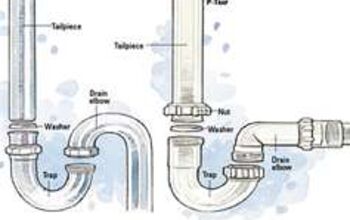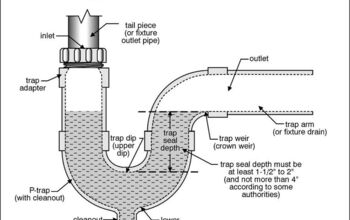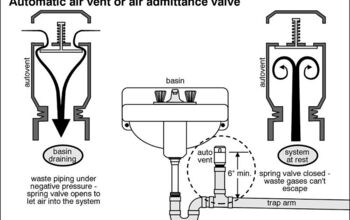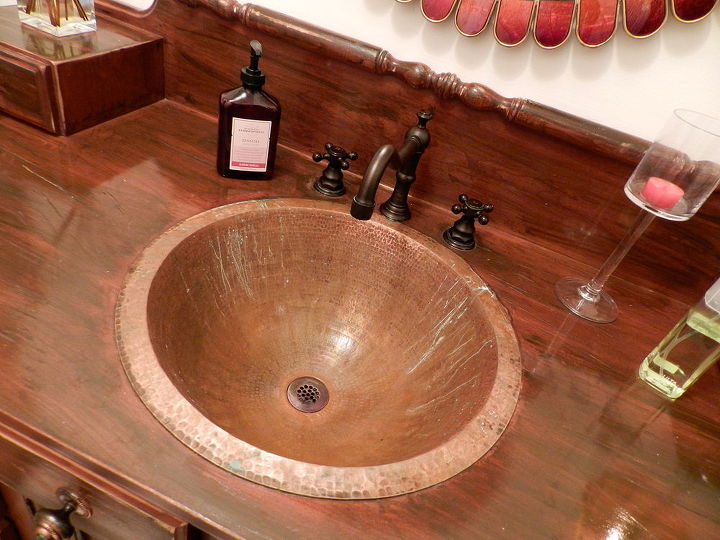How can I stop my sink from leaking and why vent inside? (stinky)

Secondly, sometimes my kitchen stinks and I've traced the smell to this vent under the sink. Why would a sewer vent be inside the house?? For background sake, my kitchen is kind of in the middle of the house on the main floor above a full, finished (kinda) basement.
-
You should replace the length of pipe feeding into "a" along with a new Nut and gasket. The piece of pipe is called a "tail piece" and appears to be 1 1/2" ...this is a standard size ( the other common size is 1 1/4") The tail piece will need to feed into the TEE with enough length to seal well...it the nut gets a little cross threaded it will not seal well. The dishwasher is feeding into a Studor vent...this eliminated the need to run a vent stack...very common in islands and remodels. Thanks for posting a pic with details...it makes it easier to figure out
 KMS Woodworks
on Jan 11, 2012
Helpful Reply
KMS Woodworks
on Jan 11, 2012
Helpful Reply -
-
Thanks KMS. Guess I'll swing by the home store on the way home. Now, what can I do about the smell coming from the vent? Vinegar? Baking Soda?? Febreeze?
 Teresa D
on Jan 11, 2012
Helpful Reply
Teresa D
on Jan 11, 2012
Helpful Reply -
-
The vent is not high enough. It is suppose to be at least as high as the top edge of the sink. The vent odor is because water has reached up to the vent itself. You need to cut the plastic pipe add an extension to it so it comes up to at least as high as the sink top. Ideally higher if you can hide it. If you need to install a few elbows use 45 degree types so it can go up and past the sink. Then replace this air vent with a new one. You cannot clean this as there is a air emitter flapper that opens when air is drawn in and closes when air is pushed against it. Once water reaches this part it sends debris into the seal thus prevents it from closing tight. Thus the smell. KMS is correct also. These plastic pipes have plastic washers that are pressed tight to the fitting when you turn the plastic nuts. If these are over tightened they warp and begin to leak. Purchase new washers at the store. They come in packs normally of two. In any case purchase a few of them as they are only about one dollar each pair. Unscrew the plastic nuts, remove the old washers, clean out the T fitting edges with soft rag to remove any dirt that has collected. Once done put the washers in so the bevel side faces the T fitting. the flat side should face the plastic nuts. Upside down they will leak. Then tighten hand tight then with pliers. Turn about 1/8 more and stop. Check water flow for leaks then tighten as needed. But the 1/8 turn should be all that is needed. Be sure that the fittings and T is square with the down pipe and discharge pipe as well. From the photo it appears that this is out of alignment. This can result is leaking as well. Some folks use Teflon tape to put on threads of the fittings. While this is ok to do, if everything is aligned up properly there should be no need to use this.
 Woodbridge Environmental Tiptophouse.com
on Jan 11, 2012
Helpful Reply
Woodbridge Environmental Tiptophouse.com
on Jan 11, 2012
Helpful Reply -
-
Does anyone see a trap...? Or am I missing it? Teresa, a "trap" is "u-shaped" and designed to hold water in it. This water blocks sewage gases from escaping from the sewer lines and coming up thru your sink drains. It should be the fitting located below the nut you have labeled as "B". It looks as though someone has at some point removed it and used two "90s" to simply align the two pipes. I can't help but think the odor is coming from the sink drains directly. If functioning properly, I believe the vent that Kevin referred to has a valve in it that is designed to let air in but not let it out. You shouldn't be getting much of an odor from there.
 Hewitt Remodeling Services LLC
on Jan 11, 2012
Hewitt Remodeling Services LLC
on Jan 11, 2012
 Helpful Reply
Helpful Reply -
-
Good catch Hewitt, but with the air vent being so low, I never even thought of the trap. Blinders must have been on.
 Woodbridge Environmental Tiptophouse.com
on Jan 11, 2012
Helpful Reply
Woodbridge Environmental Tiptophouse.com
on Jan 11, 2012
Helpful Reply -
-
Thanks guys. I'm going to work on this this weekend. So, I'm buying replacement pipe and nut for "A" and the pipe above it. I need a trap, so I can replace the piece below "B" with a trap. I'm not sure I have enough space to bring the vent up much higher but I'll see. And to make sure the pipes are aligned. Right?
 Teresa D
on Jan 12, 2012
Helpful Reply
Teresa D
on Jan 12, 2012
Helpful Reply -
-
Teresa, Correct. It is possible under the right conditions, as Bob (Woodbridge) mentioned, that water could be backing up into the vent itself because it is so low. So, the higher the better. Ideally, I would try and get it at least above the lowest sink drain. If that drain is right under the sink, you can offset it like Bob mentioned so it can miss the sink and go up along side it. Have fun and keep smiling.... Tim
 Hewitt Remodeling Services LLC
on Jan 12, 2012
1 marked as helpful Reply
Hewitt Remodeling Services LLC
on Jan 12, 2012
1 marked as helpful Reply -
-
You may not have room to install a standard trap below as you may like. But that of course is the first choice. If not you can use what is called an S trap, Although not something that is approved in new construction, but on older home retrofits can be used. You did not say what sink this is for. Baths use 1-1/4 and kitchens use 1-1/2 inch fittings. If this is for a utility sink use the larger of the two also. Also be sure that this sink does not already have a trap located below the cabinet hidden somewhere. I have seen this on more then one occasion. You cannot have two traps on same line. Based on the 2nd photo you can see that as long as the air vent is above six inches above the drain weir going out after the trap you will be ok. So you may be fine with what you already have.
 Woodbridge Environmental Tiptophouse.com
on Jan 12, 2012
Woodbridge Environmental Tiptophouse.com
on Jan 12, 2012

 Helpful Reply
Helpful Reply -
-
This complete system is just one big mess. You need someone that knows what they are doing to fix this. Sure you can replace the parts your self, but with out proper understanding of piping it may just be a waste of time. By the way where is your trap??????? I have to say it looks like it was removed and replaced with glued parts.................. Bad plumbing.........
 Hudson Designs
on Jan 12, 2012
Helpful Reply
Hudson Designs
on Jan 12, 2012
Helpful Reply -
-
This is my kitchen sink. It is located in an island. I am having someone come by this afternoon to talk about my wall oven and cooktop and how I can remodel my kitchen a little at a time. Maybe I will show it to him and see what he thinks before I do anything. At a minimum, I have to stop the leak from that side of the sink because it runs down the pipe into the basement ceiling and drips onto the bar. I have to replace the stained ceiling tiles. If I can just replace the tail piece like KMS suggested to fix the leak for the time being, maybe that's what I'll do and leave the rest (trap and vent) to the professionals when I have the sink and fixtures replaced (eventually).
 Teresa D
on Jan 12, 2012
Helpful Reply
Teresa D
on Jan 12, 2012
Helpful Reply -
-
Chances are just a gasket will fix the leak...I too missed the trap...Thanks Tim...again. Then alignment that WoodBridge note could be corrected with one of those accordion type tailpieces...that may be part of the leakage problem too.
 KMS Woodworks
on Jan 12, 2012
Helpful Reply
KMS Woodworks
on Jan 12, 2012
Helpful Reply -
-
By the way, word is that the original homeowners remodeled the kitchen. They used alot of handy men when they were fixing things preparing the house for sale (I saw the receipts) There is no doubt in my mind that there is plenty in the house that is not necessarily up to code - afterall, I watched enough Holmes on Homes, DIY and HGTV to be dangerous! The house was inspected 3 times before I purchased it. The only thing that was said about this plumbing was that the pipe leading from the garbage disposal should be on a downward tilt. Anyway, I am very handy myself and once given proper direction, I can fix lots of things. I'm not too proud to bring in the professionals if it is over my head though.
 Teresa D
on Jan 12, 2012
Helpful Reply
Teresa D
on Jan 12, 2012
Helpful Reply -
-
before adding a trap you should check the basement below the kitchen sink, the trap may have been installed down there when the house was built, and then the handyman came in, and did not know what he was doing and has just made a mess of everything, you may not even need the mechanical vent, as a vent through the roof may have been when the house was built.
 Plumbrite
on Jan 12, 2012
Helpful Reply
Plumbrite
on Jan 12, 2012
Helpful Reply -
-
Hi Teresa, Traps are part of the UPC code, not sure what State your in, but either way you have to have a trap so that methane gases don't escape back into your house, plus the sewer smells nasty. Also there are important vent codes to every fixture, if you go to my web site you can down load the UPC codes under "Residential Do it Yourself" page, right at the top, click the link and download chapter #9 Vents. Also, the vent must vent outside, and be no less than 6" from the top of the roof, it should also be waterproof. In a continuous waste, you must use a sanitary tee or baffle tee, that looks ok in your picture. PVC (like the pipe in your picture) is ok for a sink drain, but if you want to get good flow, less resistance to debris, and build it cheaper, then I recommend an ABS pipe set with a union trap. However, this is not a do it yourself set, it's worth the extra money to hire a plumber to correct these code violations and repair the pipe at the same time. Sometimes in do it yourself applications, we don't realize all the codes, and how each twist of the pipe can put us in violation of sanitary practices. The first step to becoming a plumber is understanding the "Sanitary Principles." These principles help us understand code, so we don't create funky diseases within our own dwelling. If you are venting straight into the house, that's going to effect an airborne disease, eventually ending you up in the hospital if the methane gas doesn't first cause an explosion. www.crdraves.com
 CR Draves . com
on Jan 12, 2012
Helpful Reply
CR Draves . com
on Jan 12, 2012
Helpful Reply -
-
CR, Great info. The use of air vents are allowed in special instances. Ideally not the best method, but never the less still OK to install if no other venting method can be installed. I suspect although do not know for sure, that there is most likely a vent somewhere near the location of the sink. Looking at the original install, someone who has no idea of what they were doing figured that they need this vent. But could be wrong on this if the sink was located somewhere other then where the sink used to be. We see very little ABS pipe in our area of the north east. Not sure why but its not even sold other then small up to 1 " sizes at our local home centers. I think it has to do with the sunlight degrading issue that ABS has. Great input about doing it correctly. To many people do not understand that even the tiniest errors can cause all sorts of drainage issues even if it looks as though it should work.
 Woodbridge Environmental Tiptophouse.com
on Jan 12, 2012
Helpful Reply
Woodbridge Environmental Tiptophouse.com
on Jan 12, 2012
Helpful Reply -
-
I wasn't sure which vent by the picture, there are vent loops for islands that are approved, but that will follow 909.0 UPC 2003 Code, and should never vent directly into an open space. 905.0 UPC will cover vent pipe grades and connections. 905.1 UPC states that vent pipes must be free of drops and sags. 905.2 UPC states that each vent pipe shall have it's invert taken off the drainage center line downstream of the trap before the sanitary tee branch. 905.3 UPC states that each vent must rise vertically 6" above the flood rim of the fixture before offsetting horizontally. 905.4 UPC All vent pipes must extend undiminished in size above the roof, or connected to a soil or waste vent of proper size. 905.5 UPC All vent pipe openings, except for Water Closets (toilets) shall not fall below the weir of the trap. 905.6 UPC Two fixtures served by a common vent pipe can waste separately into an approved (double fixture tee) having openings at the same level. 906.1 UPC Each vent pipe shall extend through its flashing and shall not terminate less than 6" above the roof. 906.2 UPC Each roof vent shall terminate not less than 10 ft from or 3 ft above an open window, door, access, air intake, or vent shaft. 910.1 UPC Combination waste and vent systems shall be permitted only where structural conditions exist that prevent this from happening, but have to be approved by AHJ or authority having jurisdiction. 910.4 UPC Each wast pipe and trap in any system shall be at least two pipe sizes larger than required in Chapter 7 of the code for sanitary waste, and at least 2 sizes larger than any fixture, tailpiece, or connection in these combination waste & vent systems. Anyway, you should also review the Traps and Interceptor Codes as well, because they specify distances. Again you can download this for free on my web site under the residential page.
 CR Draves . com
on Jan 13, 2012
Helpful Reply
CR Draves . com
on Jan 13, 2012
Helpful Reply -
-
Update: So, I fixed my sink this morning. I replaced the tail piece, both gaskets (top and bottom). And I used thread tape. Turns out, the tailpiece was too short. If you unscrew "A", the tailpiece didn't sit down in the nook of the T piece and the gasket at "A" was loose and apparently wasn't doing the job anymore. I'm still puzzled as to why it started leaking all of a sudden when I've not changed anything. That tailpiece has apparently always been too short. I'll deal with the missing trap issue later. Next thing to do is to get rid of the stinky smells from the vent. Thanks to everyone!!
 Teresa D
on Jan 15, 2012
Helpful Reply
Teresa D
on Jan 15, 2012
Helpful Reply -
-
congrats on getting the leak squared away...with out a trap the smell are going to be present...and not caused by the vent.. If you get into the habit of using the sinks drain plugs when not actually being "in use" this should hold a good bit of the smell at bay....until the trap can be installed.
 KMS Woodworks
on Jan 16, 2012
Helpful Reply
KMS Woodworks
on Jan 16, 2012
Helpful Reply -
-
Hire Hewitt Remoldelling and let him resolve all of this problem. This job is for a professional.
 Johnny J
on Mar 22, 2012
Helpful Reply
Johnny J
on Mar 22, 2012
Helpful Reply -
-
I actually did finally call a plumber. It started leaking again and smell was still there so I called a professional. Traps were present but under the floor like someone mentioned above. He raised the vent up higher and replaced the piping (again). I don't know why it worked for him but not me. Oh, well. I guess that's why he's a professional. Thanks again everyone for the feedback and help!
 Teresa D
on Mar 22, 2012
Helpful Reply
Teresa D
on Mar 22, 2012
Helpful Reply -
Related Discussions
How to get rid of mice?
We seem to have some unwelcome Mickeys and Minnies in our house. What is the best way to get rid of them?
How to remove popcorn ceiling with asbestos?
I want to remove my popcorn ceiling, but it has asbestos in it. How do I go about this safely?
How to caulk baseboard gaps?
How do I fill gaps at baseboard, should I caulk? If so, does anyone know how to caulk baseboards?
How to fix squeaky hardwood floors?
How do I fix squeaky hardwood floors?
I have ruined my copper sink! Please help!
I'm hoping to save my copper sink, but I am afraid I have totally ruined it. I need some suggestions on how to save it! What can I spray it with, or where can I fin... See more
Black stuff in home water supply.
This black oily or paraffin type stuff sometimes comes through my hot water line in the second story. Have talked to the water company. They say it isn't them or th... See more






